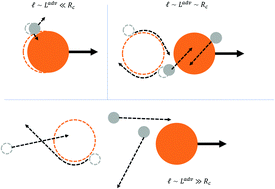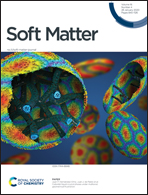Nonlinear microrheology of active Brownian suspensions
Abstract
The rheological properties of active suspensions are studied via microrheology: tracking the motion of a colloidal probe particle in order to measure the viscoelastic response of the embedding material. The passive probe particle with size R is pulled through the suspension by an external force Fext, which causes it to translate at some speed Uprobe. The bath is comprised of a Newtonian solvent with viscosity ηs and a dilute dispersion of active Brownian particles (ABPs) with size a, characteristic swim speed U0, and a reorientation time τR. The motion of the probe distorts the suspension microstructure, so the bath exerts a reactive force on the probe. In a passive suspension, the degree of distortion is governed by the Péclet number, Pe = Fext/(kBT/a), the ratio of the external force to the thermodynamic restoring force of the suspension. In active suspensions, however, the relevant parameter is Ladv/ = UprobeτR/U0τR ∼ Fext/Fswim, where Fswim = ζU0 is the swim force that propels the ABPs (ζ is the Stokes drag on a swimmer). When the external forces are weak, Ladv ≪
= UprobeτR/U0τR ∼ Fext/Fswim, where Fswim = ζU0 is the swim force that propels the ABPs (ζ is the Stokes drag on a swimmer). When the external forces are weak, Ladv ≪  , the autonomous motion of the bath particles leads to “swim-thinning,” though the effective suspension viscosity is always greater than ηs. When advection dominates, Ladv ≫
, the autonomous motion of the bath particles leads to “swim-thinning,” though the effective suspension viscosity is always greater than ηs. When advection dominates, Ladv ≫  , we recover the familiar behavior of the microrheology of passive suspensions. The non-Newtonian behavior for intermediate values of Ladv/
, we recover the familiar behavior of the microrheology of passive suspensions. The non-Newtonian behavior for intermediate values of Ladv/ is determined by
is determined by  /Rc = U0τR/Rc—the ratio of the swimmer's run length
/Rc = U0τR/Rc—the ratio of the swimmer's run length  to the geometric length scale associated with interparticle interactions Rc = R + a. The results in this manuscript are approximate as they are based on numerical solutions to mean-field equations that describe the motion of the active bath particles.
to the geometric length scale associated with interparticle interactions Rc = R + a. The results in this manuscript are approximate as they are based on numerical solutions to mean-field equations that describe the motion of the active bath particles.



 Please wait while we load your content...
Please wait while we load your content...
